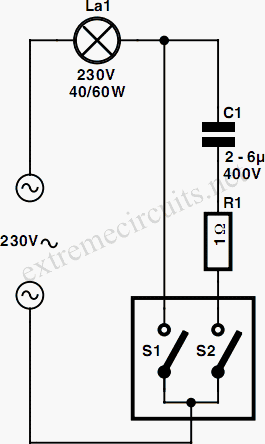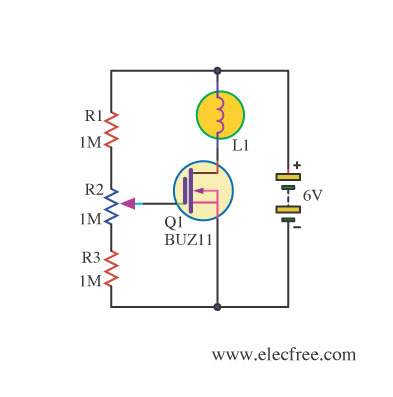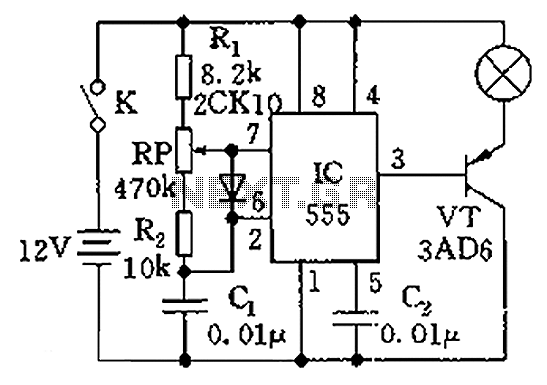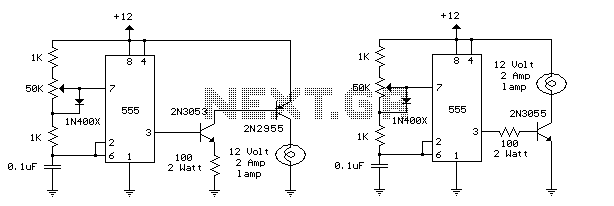
Two-Position Dimmer

This simple dimmer consists of only two components and can be easily integrated into a mains switch. It is essential to first switch off the associated branch circuit in the fuse box, as mains voltage poses a danger. The circuit requires minimal explanation. When switch S1 is closed, the lamp operates at full brightness, and the position of switch S2 is irrelevant. When S1 is open and S2 is closed, the capacitor creates a voltage drop, dimming the lamp. The power dissipation across the capacitor is negligible, preventing heat generation within the circuit. A resistor is included to prevent sparking when S2 is closed while S1 is already engaged. The capacitor value should be tailored to the power rating of the lamp being dimmed, typically ranging from 2 to 6 µF. It is crucial to use a class X2 capacitor, and this circuit is designed to work exclusively with resistive (non-inductive) loads, as unpredictable behavior may occur with inductive loads.
The described dimmer circuit operates using a straightforward configuration that includes a switch (S1), another switch (S2), a capacitor, and a resistor. The functionality hinges on the interaction between these components. When S1 is closed, it allows the full supply voltage to reach the load, which is typically a lamp, enabling it to illuminate at full intensity. The role of S2 becomes significant when S1 is open. In this state, closing S2 connects the capacitor in parallel with the load, effectively reducing the voltage across the lamp and thereby dimming it.
The capacitor serves as a critical component that influences the dimming effect. By selecting a capacitor value between 2 µF and 6 µF, the desired dimming level can be achieved based on the lamp's power rating. The choice of a class X2 capacitor is vital due to its safety rating, which ensures it can handle the potential voltage spikes encountered in AC mains applications without failure.
The resistor included in the circuit is essential for preventing arcing or sparking at the contacts of S2 during operation. This is particularly important because, without this resistor, the abrupt connection of the capacitor could lead to a sudden inrush of current, potentially damaging the switch or causing safety hazards.
It is important to note that this dimmer circuit is specifically designed for resistive loads, such as incandescent lamps. The presence of inductive loads, such as motors or transformers, may lead to erratic behavior due to the phase differences introduced by inductance, which the circuit is not designed to handle. Therefore, careful consideration of the load type is necessary when implementing this dimmer circuit to ensure safe and reliable operation.This super-simple dimmer consists of only two components, and it can easily be built into a mains switch. If you do this, don`t forget torst switch off the associated branch circuit in the fuse box, since the mains voltage is always dangerous!
The circuit does not need much explanation. When S1 is closed, the lamp works at full strength, and t he position of S2 does not matter. When S1 is open and S2 is closed, the capacitor causes a voltage drop, so the lamp is dimmed. The power dissipation of the capacitor is practically zero, so the circuit does not generate any heat. The resistor prevents sparking when S2 is closed while S1 is already closed. The value of the capacitor can be matched to the power of the lamp to be dimmed; it should be between 2 and 6 µF.
Be sure to use a class X2 capacitor. Also, don`t forget that this circuit works only with resistive (non-inductive) loads. Unpredictable things can happen with an inductive load! 🔗 External reference
The described dimmer circuit operates using a straightforward configuration that includes a switch (S1), another switch (S2), a capacitor, and a resistor. The functionality hinges on the interaction between these components. When S1 is closed, it allows the full supply voltage to reach the load, which is typically a lamp, enabling it to illuminate at full intensity. The role of S2 becomes significant when S1 is open. In this state, closing S2 connects the capacitor in parallel with the load, effectively reducing the voltage across the lamp and thereby dimming it.
The capacitor serves as a critical component that influences the dimming effect. By selecting a capacitor value between 2 µF and 6 µF, the desired dimming level can be achieved based on the lamp's power rating. The choice of a class X2 capacitor is vital due to its safety rating, which ensures it can handle the potential voltage spikes encountered in AC mains applications without failure.
The resistor included in the circuit is essential for preventing arcing or sparking at the contacts of S2 during operation. This is particularly important because, without this resistor, the abrupt connection of the capacitor could lead to a sudden inrush of current, potentially damaging the switch or causing safety hazards.
It is important to note that this dimmer circuit is specifically designed for resistive loads, such as incandescent lamps. The presence of inductive loads, such as motors or transformers, may lead to erratic behavior due to the phase differences introduced by inductance, which the circuit is not designed to handle. Therefore, careful consideration of the load type is necessary when implementing this dimmer circuit to ensure safe and reliable operation.This super-simple dimmer consists of only two components, and it can easily be built into a mains switch. If you do this, don`t forget torst switch off the associated branch circuit in the fuse box, since the mains voltage is always dangerous!
The circuit does not need much explanation. When S1 is closed, the lamp works at full strength, and t he position of S2 does not matter. When S1 is open and S2 is closed, the capacitor causes a voltage drop, so the lamp is dimmed. The power dissipation of the capacitor is practically zero, so the circuit does not generate any heat. The resistor prevents sparking when S2 is closed while S1 is already closed. The value of the capacitor can be matched to the power of the lamp to be dimmed; it should be between 2 and 6 µF.
Be sure to use a class X2 capacitor. Also, don`t forget that this circuit works only with resistive (non-inductive) loads. Unpredictable things can happen with an inductive load! 🔗 External reference





